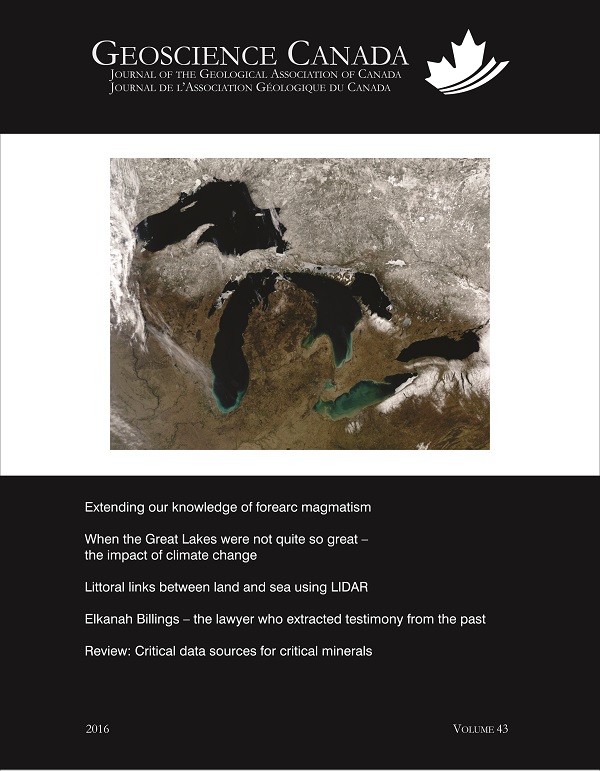Andrew Hynes Series: Tectonic Processes
Magmatism and Extension in the Foreland and Near-Trench Region of Collisional and Convergent Tectonic Systems
Published 2016-09-30
How to Cite
Schoonmaker, A., Kidd, W. S., & Ashcroft, T. (2016). Magmatism and Extension in the Foreland and Near-Trench Region of Collisional and Convergent Tectonic Systems. Geoscience Canada, 43(3), 159–178. https://doi.org/10.12789/geocanj.2016.43.100
Abstract
Foreland magmatism occurs in the lower plate during arc–continent or continent–continent collision, although it is uncommon. Ancient examples are recognized by a stratigraphic section into which mafic lavas and/or shallow sills are emplaced at a level at the top of a passive margin cover sequence, or within the overlying deeper water deposits that include mudrocks and flysch-type turbidites. Extensional structures associated with the emplacement of the volcanic rocks may develop slightly prior to or contemporaneous with the arrival of the approaching thrust front. We have selected twelve examples of magmatism in collisional forelands, modern and ancient, and have compared the tectonic associations of the magmatism with the magmatic geochemistry.Foreland magmatic settings fall into two strikingly distinct geochemical groups: a more enriched alkaline group (Rhine-type) and a more heterogeneous tholeiitic group (Maine-type) that may show traces of prior subduction processes. In the examples where the contemporaneous extensional structures are known, faults and basins develop parallel to the thrust front for the tholeiitic group and have oblique orientations, in several cases at a high angle to the thrust front, for the alkaline group. The geochemical results are quite sufficiently distinct to permit discrimination of these two foreland magmatic rock suites from each other in ancient examples where the foreland setting is clear from geological evidence. However, magmatic products of the same range of compositions can be generated in other tectonic environments (rifts, back-arc basins), so the geochemical characteristics alone are insufficient to identify a foreland basin setting.
The alkaline Rhine-type group formed primarily in response to localized upwelling convective activity from the sub-asthenospheric mantle beneath the lower plate during collision while the tholeiitic Maine-type group formed primarily in response to melting of subcontinental asthenospheric mantle during extension of the lower plate by slab pull, and resulting lithospheric detachment. It is possible that there has been a long-term secular decrease in the occurrence of the Maine-type foreland magmatism since the early Proterozoic.
RÉSUMÉ
Bien que peu fréquent, il arrive qu’un magmatisme d’avantpays se produise dans la plaque inférieure durant une collision arc-continent ou continent-continent. Des exemples anciens ont été décrits dans une coupe stratigraphique renfermant des laves mafiques et/ou des filons-couches au haut d’une séquence de couverture de marge passive, ou au sein de dépôts de plus grandes profondeurs comme des boues ou des turbidites de type flysch. Des structures d’étirement associées à la mise en place des roches volcaniques peuvent se développer un peu avant ou en même temps que l’arrivée du front de chevauchement. Nous avons choisi douze exemples de magmatisme au sein d’avant-pays de collision, modernes et anciens, et nous avons comparé les associations tectoniques du magmatisme avec la géochimie magmatique.
Les configurations magmatiques d’avant-pays se divisent en deux groupes géochimiques très différents : un groupe alcalin plus enrichi (type-Rhin), et un groupe tholéiitique plus hétérogène (type-Maine) et qui peut montrer des traces de précédentes activités de subduction. Dans les exemples où les structures d’étirement contemporaines sont connues, les failles et les bassins se développent parallèlement au front de chevauchement pour le groupe tholéiitique, alors que leurs orientations sont obliques, voire à angles aigus au front de chevauchement pour le groupe alcalin. Les résultats géochimiques sont suffisamment distincts pour permettre de distinguer ces deux suites de roches magmatiques dans les exemples anciens où la configuration d’avant-pays est évidente de par sa géologie. Cependant, des produits magmatiques de même type compositionnel peuvent advenir dans d’autres environnements tectoniques (fosses, bassins d’arrière-arc), et donc, la caractérisation géochimique seule ne permet pas de distinguer une configuration de bassin d’avant-pays.
Le groupe alcalin de type-Rhin s’est principalement formé en réponse à une activité d’éruption de convection issue du manteau sous-asthénosphérique sous la plaque inférieure durant la collision, alors que le groupe tholéiitique de type-Maine s’est formé principalement en réaction à la fusion du manteau sous-continental asthénosphérique durant l’extension de la plaque inférieure par étirement de la plaque, et le détachement lithosphérique qui en découle. Depuis le Protérozoïque, est possible qu’il y ait eu une décroissance progressive à long terme des événements magmatiques de type-Maine.
